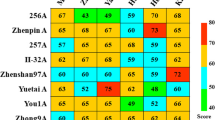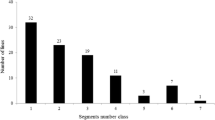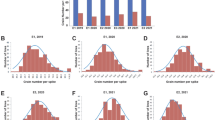Abstract
Improving the combining ability for grain quality traits of the parents is the key factor to enhance averaged bulk grain quality of hybrid japonica rice. Eight quality traits including brown rice rate, milled rice rate (MRR), head rice rate (HRR), chalkiness degree (CD), percentage of chalky grain (PCG), alkali spreading value (ASV), gel consistency (GC) and amylose content (AC) of the bulked sample of rough rice harvested from the 81 F1 hybrid plants were investigated in 2014 and 2015. By combining the phenotypic data of general combining ability (GCA) for the quality traits with genotypic data of single nucleotide polymorphism (SNP) obtained by genotyping by sequencing method, CAScreen1.0 program compiled by MATLAB language was conducted to identify the elite SNP genotype associated with combining ability of quality traits in parents. Totally 35 elite SNP genotypes involving 22 genes (genotypes) were detected associated with GCA of seven quality traits (P < 0.05) in both 2014 and 2015. Seven and four SNPs were detected associated with combining ability for MRR and HRR, respectively. For PCG and CD, six and ten SNPs were detected associated with combining ability of parents, respectively. Six SNPs involving two genes were detected for combining ability of GC. Only two SNPs were detected which associated with combining ability for ASV. For combining ability of AC, six elite SNPs genotype were detected. Among them, elite SNP genotype of LOC_Os08g25220 (T/C) located on chromosome 8 could significantly reduce AC content in mixed rice samples of hybrid japonica rice.






Similar content being viewed by others
Abbreviations
- BRR:
-
Brown rice rate
- MRR:
-
Milled rice rate
- HRR:
-
Head rice rate
- ASV:
-
Alkali spreading value
- GC:
-
Gel consistency
- CD:
-
Chalkiness degree
- PCG:
-
Percentage of chalky grain
- AC:
-
Amylose content
- SSR:
-
Simple sequence repeat
- SNP:
-
Single nucleotide polymorphism
- GBS:
-
Genotyping by sequencing
- GCA:
-
General combining ability
- SCA:
-
Special combining ability
- CMS:
-
Cytoplasmic male sterile line
References
Allahgholipour M, Ali A (2006) Gene action and combining ability for grain yield and its components in rice. J Sustain Agric 28:39–53
Beck DL, Vasal SK, Crossa J (1990) Heterosis and combining ability of CIMMYT’s tropical early and intermediate maturity maize (Zea mays L.) germplasm. Maydica 35:279–285
Bollich C (1957) Inheritance of several economic quantitative characters in rice. Diss Abstr 17:1638
Chang T (1974) Studies on the inheritance of grain shape of rice. J Taiwan Agric Res Inst 23:9–15
Cingolani P, Platts A, Wang LL, Coon M, Nguyen T, Wang L, Land SJ, Lu X, Ruden DM (2012) A program for annotating and predicting the effects of single nucleotide polymorphisms, SnpEff: SNPs in the genome of Drosophila melanogaster strain w1118; iso-2; iso-3. Fly 62:80
Dong X, Zhang D, Liu J, Liu Q, Liu H, Tian L, Jiang L, Qu L (2015) Plastidial disproportionating enzyme participates in starch synthesis in rice endosperm by transferring maltooligosyl groups from amylose and amylopectin to amylopectin. Plant Physiol 169(4):2496–2512
Fu F, Xue H (2010) Coexpression analysis identifies rice starch regulator1, a rice AP2/EREBP family transcription factor, as a novel rice starch biosynthesis regulator. Plant Physiol 154(2):927–938
Fujita N, Toyosawa Y, Utsumi Y, Higuchi T, Hanashiro I, Ikegami A, Akuzawa S, Yoshida M, Mori A, Inomata K, Itoh R, Miyao A, Hirochika H, Satoh H, Nakamura Y (2009) Characterization of pullulanase (PUL)-deficient mutants of rice (Oryza sativa L.) and the function of PUL on starch biosynthesis in the developing rice endosperm. J Exp Bot 60:1009–1023
Gao Z, Zeng D, Cheng F, Tian Z, Guo L, Su Y, Yan M, Jiang H, Dong G, Huang Y, Han B, Li J, Qian Q (2011) ALK, the key gene for gelatinization temperature, is a modifier gene for gel consistency in rice. J Integr Plant Biol 53:756–765
Han L, Wei X (2006) Description and specification of rice germplasm resources. China Agriculture Press, Beijing
Han X, Wang Y, Liu X, Jiang L, Ren Y, Liu F, Peng C, Li J, Jin X, Wu F, Wang J, Guo X, Zhang X, Cheng Z, Wan J (2012) The failure to express a protein disulphide isomerase-like protein results in a floury endosperm and an endoplasmic reticulum stress response in rice. J Exp Bot 63:121–130
Hirose T, Scofield G, Terao T (2008) An expression analysis profile for the entire sucrose synthase gene family in rice. Plant Sci 174:534–543
Hong D (2010) Experimental technique of crop breeding. Science Press, Beijing
Hong D, Leng Y (2004) Genetic analysis of heterosis for number of spikelets per panicle and panicle length of F1 hybrids in japonica rice hybrids. Chin J Rice Sci 11:255–260
Hong D, Yang K, Pan E (2002) Heterosis of F1 s derived from different ecological types and combining ability of their parents in japonica rice (Oryza sativa). Chin J Rice Sci 16:216–220
Huang D, Liang K, Sun C, Jiang J, Shi M, Dai J, Xie H, Zhao K, Ruan F, Ma W, Hong D (2011) Identification of marker genotypes associated with elite combining ability for quality traits in parents of hybrid japonica rice (Oryza sativa L.). Acta Agron Sin 37:405–414
Jin W, Zhang W, Hong D (2005) Heterosis of late-maturing japonica hybrids (Oryza sativa L.) and parent’s combining ability in south jiangsu region. Acta Agron Sin 31:1478–1484
Kang H, Park S, Matsuoka M, An G (2005) White-core endosperm floury endosperm-4 in rice is generated by knockout mutations in the C-4-type pyruvate orthophosphate dikinase gene (OsPPDKB). Plant J 42:901–911
Khush GS, Kumar I, Virmani SS (1988) Grain quality of hybrid rice. Hybrid Rice, Manila
Kumar I, Khush GS (1986) Genetics of amylose content in rice (Oryza sativa L.). J Genet 65:1–11
Kumar I, Khush GS (1988) Inheritance of amylose content in rice (Oryza sativa L.). Euphytica 38:261–269
Kumar I, Khush G, Juliano B (1987) Genetic analysis of waxy locus in rice (Oryza sativa L.). Theor Appl Genet 73:481–488
Langmead B (2010) Aligning short sequencing reads with Bowtie. Curr Protoc Bioinform 32(1):11–17
Li J, Hong D (2004) Combining ability analysis of main agronomic and quality characters of BTtype cytoplasmic male sterile lines newly bred in japonica rice (Oryza sativa L.). J Nanjing Agric Univ 27:11–16
Li J, Hong D (2005) Combining ability for agronomic and quality characters of BT type iso-cytoplas-mic restorer lines newly bred in japonica rice (Oryza sativa L.). Acta Agron Sin 31:851–857
Li Y, Fan C, Xing Y, Yun P, Luo L, Yan B, Peng B, Xie W, Wang G, Li X, Xiao J, Xu C, He Y (2014) Chalk5 encodes a vacuolar H + -translocating pyrophosphatase influencing grain chalkiness in rice. Nat Genet 46:398–404
Liang K, Huang D, Zhao K, Ruan F, Xie H, Ma W, Hong D (2010) Screening marker genotypes with elite combining ability for yield traits in parents of hybrid japonica rice (Oryza sativa L.). Acta Agron Sin 36:1270–1279
Liu X, Wu J (1998) SSR heterogenic patterns of parents for marking and predicting heterosis in rice breeding. Mol Breed 4:263–268
Liu X, Ishiki K, Wang W (2002) Identification of AFLP markers favorable to heterosis in hybrid rice. Breed Sci 52:201–206
Liu X, Chen S, Chen J, Ishiki K, Wang W, Yu L (2004) Improvement of combining ability for restorer lines with the identified SSR markers in hybrid rice breeding. Breed Sci 54:341–346
Liu E, Liu Y, Liu X, Liu Q, Zhao K, Mawuli W, Hong D (2013) Detecting marker genotypes with elite combining ability for yield traits in parents of hybrid japonica rice. Chin J Rice Sci 27:473–481
Liu Y, Liu E, Zeng S, Pu W, Liu Q, Liang L, Liu P, Zhang Q, Hong D (2015) Identification of molecular marker fragments associated with combining ability for quality traits in parents of hybrid japonica rice (Oryza sativa L.). Chin J Rice Sci 29:373–381
Mao C (2010) Developing indica-type hybrid in China: accelerating hybrid rice development. International Rice Research Institute, Los Banos
Matsushima R, Maekawa M, Kusano M, Kondo H, Fujita N, Kawagoe Y, Sakamoto W (2014) Amyloplast-localized SUBSTANDARD STARCH GRAIN4 protein influences the size of starch grains in rice endosperm. Plant Physiol 164:623–636
Mikami I, Uwatoko N, Ikeda Y, Yamaguchi J, Hirano H, Suzuki Y, Sano Y (2008) Allelic diversification at the wx locus in landraces of Asian rice. Theor Appl Genet 116:979–989
Mitra G (1962) Inheritance of grain siza in rice. Curr Sci 31:105–106
Mo H (1982a) The analysis of combining ability in pxq mating pattern (continued). J Jiangsu Agric Coll 3:53–57
Mo H (1982b) The analysis of conibining ability in pxq mating pattern. J Jiangsu Agric Coll 3:51–57
Nakatat S, Jackson B (1973) Inheritance of some physical grain quality characteristics in a cross between a Thai and Taiwanese rice. Thai J Agric Sci 6:223–235
Parson W, Strobl C, Huber G, Zimmermann B, Gomes S, Souto L, Fendt L, Delport R, Langit R, Wootton S, Lagace R, Irwin J (2013) Evaluation of next generation mtGenome sequencing using the Ion Torrent Personal Genome Machine (PGM). Forensic Sci Int-Genet 7:543–549
Poland J, Brown P, Sorrells M, Jannink J (2012) Development of high-density genetic maps for barley and wheat using a novel two-enzyme genotyping-by-sequencing approach. PLoS ONE 7:e32253
Pradeep AR, Jingade AH, Urs RS (2007) Molecular markers for biomass traits: association, interaction and genetic divergence in silkworm Bombyx mori. Biomark Insights 2:197–217
Ramiah K, Parthasarthy N (1933) Inheritance of grain lengrh in rice (Oryza sativa L.). India J Agric Sci 3:808–819
Rice Editorial Office of China (2003) Ministry of agriculture industry standard: quality of rice varieties NY/T-593-2002. China Rice 2:43–44
Shukla S, Pandey M (2008) Combining ability and heterosis over environments for yield and yield components in two-line hybrids involving thermosensitive genic male sterile lines in rice (Oryza sativa L.). Plant Breed 127:28–32
Somrith B, Chang T, Jackson B (1979) Genetic analysis of traits related to grain characteristics and quality in two crosses of rice. IRRI Research Paper Series, Manila
Spindel J, Wright M, Chen C, Cobb J, Gage J, Harrington S, Lorieux M, Ahmadi N, McCouch S (2013) Bridging the genotyping gap: using genotyping by sequencing (GBS) to add high-density SNP markers and new value to traditional bi-parental mapping and breeding populations. Theor Appl Genet 126:2699–2716
Sun W, Zhou Q, Yao Y, Qiu X, Xie K, Yu S (2015) Identification of genomic regions and the isoamylase gene for reduced grain chalkiness in rice. PLoS ONE 10:e0122013
Wang Y, Ren Y, Liu X, Jiang L, Chen L, Han X, Jin M, Liu S, Liu F, Lv J, Zhou K, Su N, Bao Y, Wan J (2010) OsRab5a regulates endomembrane organization and storage protein trafficking in rice endosperm cells. Plant J 64:812–824
Wu W, Zheng X, Lu G, Zhong Z, Gao H, Chen L, Wu C, Wang H, Wang Q, Zhou K, Wang J, Wu F, Zhang X, Guo X, Cheng Z, Lei C, Lin Q, Jiang L, Wang H, Ge S, Wan J (2013) Association of functional nucleotide polymorphisms at DTH2 with the northward expansion of rice cultivation in Asia. Proc Natl Acad Sci USA 110:2775–2780
Xie F, Hardy B (eds) (2009) Accelerating hybrid rice development. International Rice Research Institute, Los Baños
Xie F, Hardy B (eds) (2014) Public-private partnership for hybrid rice. International Rice Research Institute, Los Baños
Xie H, Huang D, Liu E, Dang X, Zeng S, Hong D (2018) Effects of improving combining ability for yield traits of restorer line using information of marker genotypes with elite combining ability in japonica rice (Oryza sativa L.). Hybrid Rice 33:55–59
Xu C, Zhang A, Zhu Q (1996) Genetic analysis of quality traits in rice crosses between indiaca and japonica. Acta Agron Sin 22:530–534
Yuan LP (1994) Increasing yield potential in rice by exploitation of heterosis. International Rice Research Institute, Manila
Zaid I, Tang W, Liu E, Khan S, Wang H, Mawuli E, Hong D (2017) Genome-wide single-nucleotide polymorphisms in CMS and restorer lines discovered by genotyping using sequencing and association with marker-combining ability for 12 yield-related traits in Oryza sativa L. subsp japonica. Front Plant Sci 8:143
Zhang C, Zhao D, Li Q, Gu M, Liu Q (2016) Progresses in research on cloning and functional analysis of key genes involving in rice grain quality. Sci Agric Sin 49:4267–4283
Zhu X, Shen S, Chen W, Shu Q (2004) Appliaction of microplate spectrophotometer in determination of apparent amylose content and mutant selection in rice. Acta Agric Nucleatae Sin 18:183–185
Acknowledgements
We thank all the breeding institutions including Jiangsu Academy of Agricultural Sciences, Changshu Institute of Agricultural Sciences, Agricultural Science Institute of Huaiyin District, Zhejiang Academy of Agricultural Sciences, China National Rice Research Institute, Xinjiang Academy of Agricultural Sciences, Agricultural Reasearch Institute of Yandu District, Tianjin Tianlong Seeds Science and Technology Co.,Ltd, Shanghai Academy of Agricultural Sciences, and Liaoning Academy of Agricultural Sciences for providing the seeds of CMS lines and restorer lines.
Funding
This work was supported by the National Natural Science Foundation of China (31571743), a grant from the doctoral fund of the Educational Ministry of China (20130097110001), a special programme of scientific research belonging to the Educational Ministry of China (KYZ2012-9) and a grant from the China Postdoctoral Science Foundation (2016M601830).
Author information
Authors and Affiliations
Contributions
DH and EL conceived and designed the experiments. EL, SSZ, YSZ, GW, DL, JJ and YL conducted the experiments. EL analysed the data and wrote the manuscript. All authors read and approved the final manuscript.
Corresponding author
Ethics declarations
Conflict of interest
The authors declare that the research was conducted in the absence of any commercial or financial relationship that could be construed as a potential conflict of interest.
Electronic supplementary material
Below is the link to the electronic supplementary material.
Rights and permissions
About this article
Cite this article
Liu, E., Zhu, S., Zeng, S. et al. Identification of genome-wide SNPs associated with combining ability for grain quality traits in parents of hybrid japonica rice (Oryza sativa L.). Euphytica 214, 217 (2018). https://doi.org/10.1007/s10681-018-2301-5
Received:
Accepted:
Published:
DOI: https://doi.org/10.1007/s10681-018-2301-5




